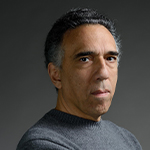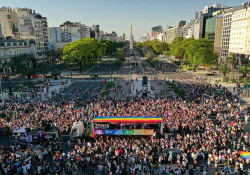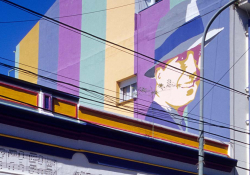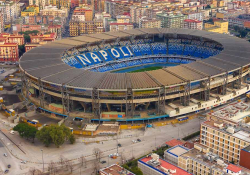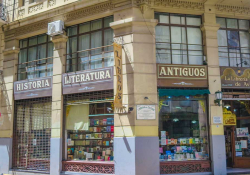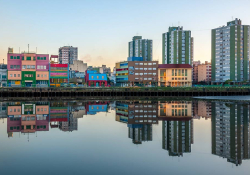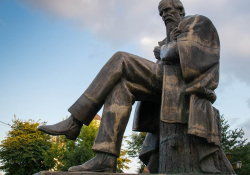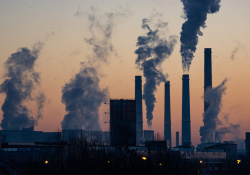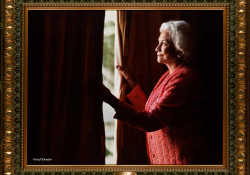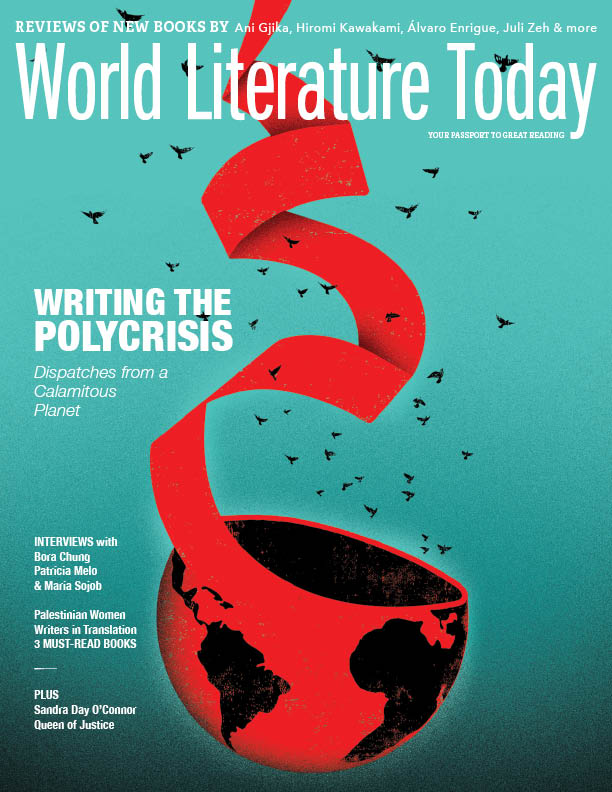Dancing at the Foot of a Volcano: Bad Governance, Corruption, and Ecological Disaster in Lebanon
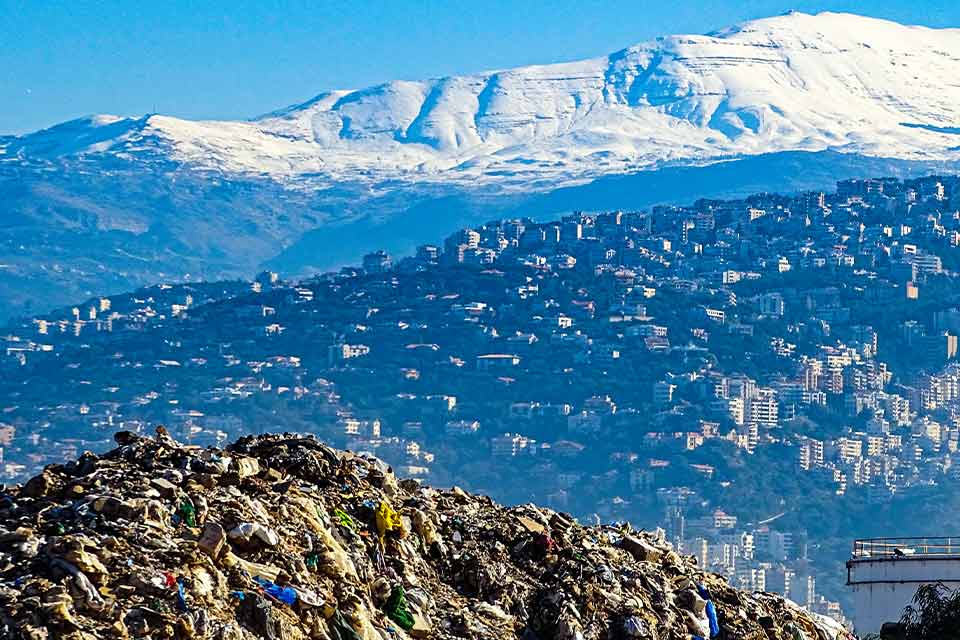
“Through a sort of grating irony,” writes Charif Majdalani, Lebanon “remains a sort of model but in the negative sense of the term, because it concentrates in itself all the problems of the contemporary world.” Will it someday regain its role as a positive model?
For almost a century, and despite the multiple conflicts that have punctuated its recent history, Lebanon has always been considered a model in its management of the confessional and religious diversity of its population. Held up as an example of peaceful coexistence between the multiple practitioners of Christianity and Islam, the Lebanese system of governance was even considered by Pope John Paul II as a “message” at a time when all countries made up of ethnic and religious mixtures were descending into conflict and division.
Lebanon is made up of a multitude of religious communities (eighteen officially) and multiple layers of migratory waves from all over the world (Armenians, Russians, Greeks, Palestinians, Kurds, Syrians, Iraqis, etc.) and has thus succeeded in persisting amidst the turmoil of history—enduring despite moments of existential crises, civil wars, and political divisions. On several occasions its model almost fell apart, and the country nearly broke apart, in particular because of the different ways in which each community declared its identity, depending on its positioning in history and geography. To put it simply, Christians have always seen, wanted, and conceived of Lebanon as a country linked to the West and different from its Arab environment, while Muslims have always valued and desired it as being anchored in the history of the Arab world. These differences—added to more specifically political questions such as the sharing of power between communities and the inadequacies of each confessional group’s various visions of the country—inevitably led to dangerous upheavals and successive political crises, notably in 1958 and then during the violent civil war from 1975 to 1990. The fact remains that these successive crises, wars, and today’s economic crisis have not succeeded in shaking the foundations of the country or endangering its very being.
Too small to be divided up, too rich and diverse to be absorbed by its neighbors, Lebanon continues to exist by a sort of permanent miracle.
Too small to be divided up, too rich and diverse to be absorbed by its neighbors, Lebanon therefore continues to exist by a sort of permanent miracle. But while its history remains punctuated by existential crises, the country of today has also recently experienced problems of all kinds linked to a disastrous public affairs policy pursued by dizzyingly corrupt political elites, to problems of migration from neighboring countries, to economic and ecological problems. Through a sort of grating irony, this country remains a sort of model but in the negative sense of the term, because it concentrates in itself all the problems of the contemporary world: problems of governance, of links between political powers and the world of finance, hyperliberal temptations, migration issues, of managing urban issues, and, finally, of severe environmental degradation.
It is obvious that all these problems are interconnected. To untangle them and understand the ecological crisis and its consequences in a country like Lebanon, it is necessary to very quickly summarize the current political and economic situation in the country. At the end of the civil conflict that pitted the various religious and confessional communities against one another between 1975 and 1990, the more or less reconciled warlords and militia leaders became politicians and took the reins of the country, bringing to power with them their entourages and members of their staffs. Formed into a true political oligarchy, for thirty years (from 1990 to 2020) these leaders took control of the state, developing together an entirely clientelist and mafia-like system of government. They took advantage of the country’s immense reconstruction project and of the gigantic financial windfall that caused the money to flow in to brazenly enrich themselves and to establish corruption as a system of governance, with the guilty consent of a powerful caste of arrogant bankers. During the thirty years separating the end of the civil war from the economic crisis and the collapse of 2020, this oligarch plundered and shared with its clientele, its relatives, and its cronies the wealth of the state and the colossal donations received from abroad. The embezzlement of colossal sums and the distribution of this organized theft at all levels of power transformed the administration of Lebanese institutions into an enterprise of organized crime and political life into real business.
We lived under a volcano from which we heard the rumblings announcing calamities to come and from which we turned away with disdain. Except the calamities arrived.
However, for thirty years, Lebanon lived carefree in the face of these terrible abuses. Money came flooding in; major projects, business, and prosperity seemed limitless; and the population turned a blind eye to the actions of men in power, because life was easy, despite everything. Beirut and Lebanon lived again—it was like before the civil war, the carefreeness and a sort of insolent dolce vita. The nights of Beirut were like no other; creativity was intense in all areas of art, design, and architecture. We lived under a volcano from which we heard the rumblings announcing calamities to come and from which we turned away with disdain. Except the calamities arrived. It was the financial and economic crisis of 2020, the collapse of the banks and then of the entire state, the ruin of depositors, the impoverishment of part of the population, and, as if to complete this sinister picture of the consequences of corruption and irresponsibility, the explosion at the port of Beirut on August 4.
In addition to the economic, psychological, and social damage, the crisis, which has not yet been resolved, also had significant consequences on the environment. But from this point of view as in everything else, the damage had already started during the previous period. From the very beginning of reconstruction, in fact, and in the frenzy of major projects intended to rebuild infrastructures damaged by the war or that had become obsolete, major projects were carried out without any respect for environmental standards. Part of the architectural heritage and appearance of old Beirut was ravaged by projects for a new city center. Laws were established authorizing unlimited exploitation of land occupancy rates and thus allowed huge gains in construction, which favored unbridled real estate speculation that took away not only a considerable number of old aristocratic residences characteristic of Lebanese Italo-Ottoman architecture but also the jewels of modernist architecture that characterized the city in the 1950s and 1960s. Buildings of dizzying size and often without any charm made the city of Beirut ugly and changed the scale of the city.
But real estate speculation was not concentrated in the Lebanese capital. On the contrary, total freedom to build led to the disorderly development of small towns and villages, took away their architectural heritage, and devastated their environment. Around Beirut, anarchic construction, begun at the time of the civil war, transformed the surroundings of the capital into a sprawling urban continuity, abolishing neighboring villages along with large orange and banana plantations. In the mountains, roads were dug with abandon, cutting up forests, valleys, and gorges. Terrifying stone- and sand-extraction quarries left indelible scars on the landscape. Magnificent sites, remains of times gone by, ancient temples, Crusade fortresses, and stately homes were unscrupulously damaged by new motorway projects or devastated by the proximity of quarries or real estate projects. The coast and its beaches were arbitrarily privatized and closed to the public, then damaged by excessive seaside construction that was often unforgivably ugly.
All this change could emanate a feeling of enormous power, obviously. The projects were so lucrative that environmental destruction seemed like a minor concern. But in a few years, Lebanon—this biblical country of milk and honey, this country of green valleys and snow-capped peaks, of languorous beaches and bays with almost feminine designs, this Eden of the Romantic poets and dream of the Arab desert tribes—was disfigured like a delicious face lacerated with knives or devoured by some leprous disease. But what did it matter, since business was prosperous, enrichment was easy, speculation seemed almost normal, and fun and entertainment also seemed limitless?
Still, the limits were there but we refused to see them—we continued to distract ourselves without wanting to look at reality, without wanting to hear the volcano rumble. Because the evidence of the near collapse of the entire edifice was right there before our eyes. The banking system of unlimited credit offers and aberrant interest rates was obviously absurd. Endemic political instability was also apparent. But they were also almost familiar flaws. The most famous example was that of the electricity sector, which emblematized the bankruptcy of the Lebanese mafia state. Because during thirty years of profiteering, anarchic development, speculation, and the motivation to enrich oneself by every means, during thirty years of great projects and gigantic corruption, successive governments could not manage to put back on its feet what yet seems essential to a country driven by such enthusiasm—namely, the electricity grid. Countless plans to restore this now-obsolete network were proposed, but all were aborted due to the inability of the various components of the political oligarchy to agree on the sharing of profits from this sector. In the meantime, enormous sums were spent on patchwork solutions, and the sum usually cited for this is forty billion dollars wasted without a result. The electricity problem was never resolved—rationing and power cuts remained the rule for thirty years, in a country strewn with buildings, skyscrapers, absurd highways in the mountains, state-of-the-art seaside resorts and clubs, and legendary nightlife.
But it didn’t matter. The famous resourcefulness and pseudoresilience of the Lebanese, which is more an extraordinary ability to adapt to all situations and turn them into the possibility of doing business, managed to resolve the problem. Faced with the state’s failure, the business of neighborhood generators was born. If the large real estate complexes and the posh buildings had their own power supply, in every street of every Lebanese city and village, in every block of houses or buildings, individuals undertook for years to offer private electricity to local residents by installing large generators and stretching wires every which way, anarchically, and taking monthly payments for their service. During all the years of prosperity, when huge projects were at work to rebuild the country and modernize its infrastructure, Lebanese oscillated in their daily lives between two electricity suppliers, the state and private generators, according to schedules that were more or less fixed but never truly stable.
The interplay between one current source and another, the various powers of current delivered by one or another of the suppliers, had significant consequences for the operation of domestic appliances in homes, not to mention a doubling of bills and costs for households. The installation of generators became a very lucrative activity, generating a real lobby and gang wars for the monopoly on energy distribution. And then, obviously, the multiplication of generators also led to environmental degradation. The uncontrolled use of fuel oil and carbon dioxide emissions through the discharge of black smoke from generators into the air were accompanied by permanent noise- and visual-pollution, due to the almost nightmarish farrago of the networking systems to the generators—the intertwined electrical wires and cables contributing to an almost surrealist ugliness in the urban landscape.
The dual source of electrical power became the norm—it entered into people’s customs to the point of seeming almost natural, and it is undoubtedly one of the great paradoxes of the last thirty years, those which preceded the crisis. The bankruptcy of the electricity sector in no way compromised major projects, real estate speculation, business, commerce, leisure, or the feeling that the country would never sink. On the contrary, the general impression was that in this area as in many others, the Lebanese were always capable of finding solutions to the shortcomings of the state through private initiative, which fueled the arguments in favor of hyperliberalism and a reduction in public services to a minimum. No one realized that the almost endemic bankruptcy of the electricity sector carried the seeds of the general bankruptcy of a country, its corrupt elites, way of life, and system of governance.
Indeed, this situation took another turn and reached another magnitude with the arrival of the economic crisis. The collapse of the state in 2020 resulted in an almost total interruption of power supplies from the public sector, which became unable to buy fuel to operate power stations. The private electricity lobby gained even more political power, but very quickly the impossibility of importing fuel shut down the generators in turn. In the summer of 2021 Lebanon was almost completely without power. When the generators were able to resume their work, they increased their prices, which, logically, generated a new business in response, that of solar energy. In a few months, to compensate for the lack of power provided by the state and to turn away from the private supply that had become extremely expensive, the Lebanese turned massively to solar panels. The desire for rapid installations everywhere became almost hysteria. Parts ran out, deliveries failed to satisfy demand, prices rose. Some generator owners even retrained in this new activity. Buildings and houses in the city were covered with panels on all sides, and Lebanon became in less than a year, albeit reluctantly, a country running on green energy.
Except that installing solar energy is not always cheap, which ends up widening the gap between those who could afford it and those who could not or could no longer afford it due to loss of money in their bank accounts. Moreover, in certain deprived regions, notably in the mountains of the north of the country, the poverty that the crisis exacerbated prevents to this day access to both solar energy and fuel oil, the price of which exceeds the means of most of the inhabitants of these regions, whose purchasing power has been greatly eroded by the devaluation of the Lebanese currency. The result is that residents fell trees to obtain coal and wood. A new business was gradually established. Bands of poachers devastate the forests and sell the wood cheaply. The venerable mountains of Lebanon thus find themselves the prey of real predators. And this is all the more worrying and damaging since most of the forests attacked are those where the highest peaks of the Mount Lebanon range are located, where rare and centuries-old species grow: arbutus, cedars, oaks, and firs.
We seem to be witnessing the last stage of a long process of deforestation that, in a unique way, began several millennia ago. The Lebanese mountains have been covered in forests since ancient times, as mentioned in many texts of antiquity. Stories from Pharaonic Egypt even report that at that time the cedars reached almost to the coast or were, in any case, quite low in altitude. But over the centuries, the peoples occupying what is now Lebanon, starting with the Phoenicians—considered by some to be the ancestors of the Lebanese—cut down trees by the thousands, which they traded with Pharaonic Egypt and with the kingdoms of Solomon and of David, according to what the Bible records. The wood was used in the funeral rites of the pharaohs and in the construction of the temple in Jerusalem, among other uses. But it was also used for everything else, in particular for making boats. At the beginning of the Christian era, the Roman emperors declared the remains of these forests “imperial domain” and prohibited their exploitation.
Today, near the summits, we can still see steles engraved in the name of Emperor Hadrian threatening loggers with sanctions in the event of disobedience. But these steles are no longer anything other than witnesses to the disappearance of the forests, because the cedars and other beautiful species they were supposed to protect have retreated further, leaving them there, a simple marker highlighting the forests’ dramatic decline. In the eighteenth century, the patriarchs of the Maronite Church, who were the main moral authority in the mountains of Lebanon, declared the cedars “the tree of God,” thereby helping preserve the last forests, which remain to this day. But with the current crisis, we seem to be returning to this movement of deforestation, even if no one is attacking the cedars, which have become a tree too strongly symbolic of Lebanese identity. But the rest of the species—oaks, strawberry trees, pines, and other conifers—suffer real devastation.
If the mountains of Lebanon are famous and celebrated in ancient texts, starting with the Bible, it is not only for their forests but also, and above all, for the water that always flowed there in abundance, and for the torrents of snow. The snow on the peaks itself was a great dream for the populations of the entire Middle East, including the people of the desert and the oases of Syria, Palestine, and Arabia. According to perhaps somewhat contrived etymologies, the very name of Lebanon derives from words designating, in ancient Semitic languages, the whiteness of mountain snow. During the founding of modern Lebanon, water was even considered, in the ideological discourse of the time, as the country’s essential natural wealth. “The others have oil,” the political class proclaimed, “but we have water. Oil is exhaustible, water is not.”
Unfortunately, nothing was ever done during the entire period of prewar opulence to intelligently exploit this remarkable resource. During the reconstruction that followed the civil war, and during the oligarchic caste’s control over the country, gigantic dam projects were set in motion. They cost colossal fortunes, amounting to billions of dollars. One would have thought that Lebanon was finally going to benefit from the waters of its mountains. Obviously, most of these projects were intended to enrich the men in power and their clientele. And when they were deemed necessary, their cost was assessed at rates much higher than their true cost. Corruption and embezzlement were rampant, and today most of the dams, often considered useless, function barely or not at all yet have contributed to damaging previously admirable sites, historic valleys, or gorges containing Edenic splendors. As such, the beautiful Mseilha Valley, a few kilometers south of the city of Tripoli, is emblematic of the combined devastation suffered by the Lebanese landscape. This valley is at the mouth of a torrent that ends in a small valley surrounded by mountains with feminine, gently rounded shapes. In the middle sits, on a sort of acropolis, a small fortress from the times of the Crusades and of the Lebanese emirates of the seventeenth and eighteenth centuries, a small, almost pictorial marvel. Over forty years, the site was ravaged by a highway on the west side, then by a stone quarry on the south side, and finally by a huge and terrible dam, often empty, on the east side—as if motivated by a methodical and relentless concern to reduce to nothing the splendid beauty of the place and its delicate poetry.
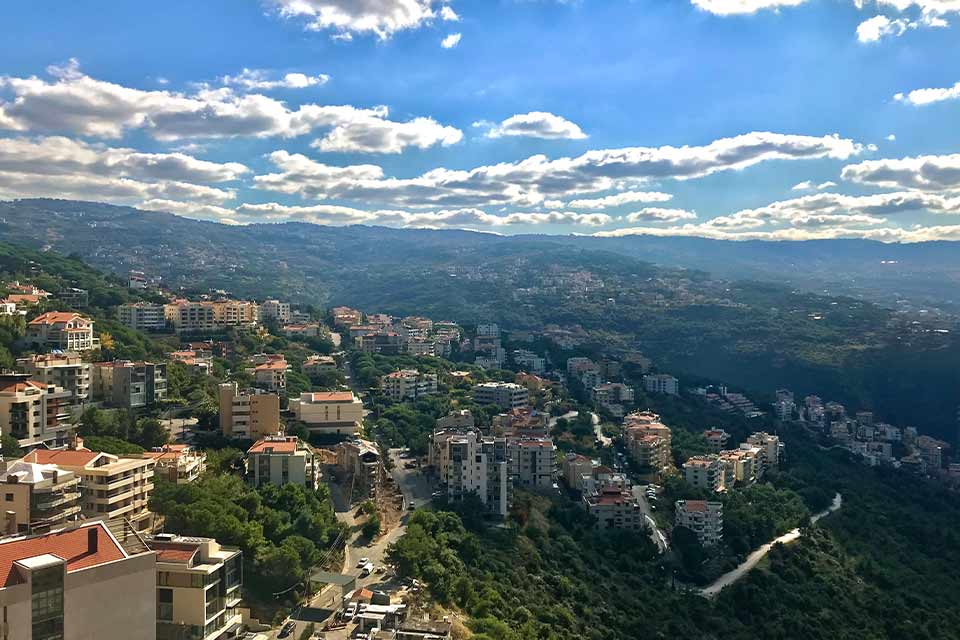
Water is in short supply, and during much of the spring and all summer, Lebanese citizens buy private water just like they buy private electricity.
In the meantime, of course, the problems remain unresolved. Water is in short supply, and during much of the spring and all summer, Lebanese citizens buy private water just like they buy private electricity. Tanker trucks constantly crisscross the streets to bring liquid to houses and buildings, without anyone wondering where it comes from. There is no doubt that hundreds of wells and springs have been looted. Only the winter season puts an end to this traffic, but global warming also contributes to confusing everything. It has rained less in Lebanon for two decades. The snow, which mainly contributes to replenishing the water table, is more and more delayed—it falls later, at higher and higher elevations, and its absence contributes to making the situation more worrisome each year, without anyone worrying about it.
If the mountains constitute one of the symbols of modern Lebanon on which its national story was built early on, another natural element has contributed to the historical fortunes of the country: the sea. Certainly, the sea is not fundamental in the Lebanese imagination; the inhabitants of Lebanon turn more generally toward their mountains. The sea was for a long time a foreign element, from which danger could arise, but also the element on which many Lebanese emigrants set out to populate the world. The relationship of Lebanese with the sea is therefore quite ambivalent, but it is all the same an essential part of their landscape, and the Lebanese coast has always been celebrated for the extreme elegance of its design, its harmonious bays, its sandy beaches. The proximity of the mountains and their large pine forests, the snow-capped peaks that can be seen from boats, even made Alphonse de Lamartine say that here, with this majestic marriage of water and snow-capped peaks, was the Switzerland of the East.
Unfortunately, during the civil war, the coastline was the object of great covetousness. The beaches and entire sections of the coast were privatized by consortia of businessmen linked to warlords. Peacetime did not allow the state to recover or evacuate any of the illegally occupied coastline. The overlapping interests of businessmen and politicians contributed to perpetuating this control over the coast, a coast otherwise largely damaged by speculation, real estate projects, and the ravages of uncontrolled urbanization.
But the greatest damage to the sea is elsewhere. As soon as the war ended, the question of waste management arose acutely. Like everything else, it appeared as a lucrative operation in the eyes of members of the political class and its crooked business clientele. As with electricity, the awarding of garbage collection contracts as well as the construction of incineration and especially recycling plants created rivalries within the oligarchy and prevented the issue from being resolved. In the meantime, for thirty years now, waste has piled up in huge open-air dumps on the seashore. These mountains of garbage give off pestilential odors. They emit toxic gases and, above all, frequently collapse into the sea and pollute it in a disastrous way.
A use was found for these vast dump sites at the start of the reconstruction era, when enormous masses of rubble from the clearing of the ruins of downtown Beirut were thrown into the sea, along with the rest of the garbage from the city. The resulting rubble and waste were flattened and treated in such a way that the surface area of the capital was increased by a few square kilometers. On these areas reclaimed from the sea, in the initial plan to rebuild the city center, buildings were to be raised and a luxurious business center constructed where billions would have continued to be generated, in the middle of the paneling and gold, in towers and malls built on garbage. This was never carried out, but the very conception of such a project is telling. It summarizes the situation in postwar Lebanon, thirty years of opulence, la dolce vita, leisure, and easy money existing at the expense of the most basic environmental issues, in total ignorance of their consequences or, even worse, used to make even more profits.
The volcano is perhaps no longer just the symbol of social or warlike violence but the metaphor of a real ecological time bomb to come.
For thirty years, we have continued—and continue despite the crisis—to live carefree about the future, to work, to have fun, and to enrich ourselves as we dance at the foot of a volcano, again and again, always. Except that the volcano is perhaps no longer just the symbol of social or warlike violence but the metaphor of a real ecological time bomb to come. It is in this sense that Lebanon appears, once again, as a negative model for the entire planet.
Beirut
Translation from the French
